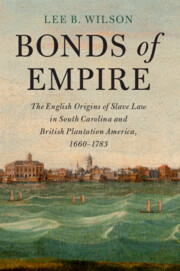 Bonds of Empire
Bonds of Empire Published online by Cambridge University Press: 02 July 2021
In Chapter Three, I move beyond plantation America’s shores to trace how the legal logic of chattel slavery projected out into the Atlantic Ocean. The idea that human beings could be treated as things at law was not landlocked. Rather, it was a legal concept that also infused the worldview of those who labored at sea. This becomes clear when we sift through the claims of the countless sailors, captains, and merchants who brought their disputes to colonial Vice Admiralty Courts, which governed life on British naval and merchant vessels. Litigants quibbled over many things in colonial Vice Admiralty Courts, but what united their disparate claims was an overarching assumption that people of African descent were valuable commodities. Vice Admiralty procedure helped to make this possible. Although English admiralty law had developed over centuries to allow European sailors and merchants to seize cargo and ships, Vice Admiralty litigants and judges extended the Courts’ in rem jurisdiction to include slaves found on captured vessels. This process of adaptation was silent and uncontested. Litigants, lawyers, and judges assumed arguendo that Vice Admiralty Courts could treat slaves as they would any other type of marine property. Without comment, they slotted enslaved people into ready-made forms and procedures, and brought black bodies before the Courts as objects that could be condemned, appraised, and sold.
To save this book to your Kindle, first ensure [email protected] is added to your Approved Personal Document E-mail List under your Personal Document Settings on the Manage Your Content and Devices page of your Amazon account. Then enter the ‘name’ part of your Kindle email address below. Find out more about saving to your Kindle.
Note you can select to save to either the @free.kindle.com or @kindle.com variations. ‘@free.kindle.com’ emails are free but can only be saved to your device when it is connected to wi-fi. ‘@kindle.com’ emails can be delivered even when you are not connected to wi-fi, but note that service fees apply.
Find out more about the Kindle Personal Document Service.
To save content items to your account, please confirm that you agree to abide by our usage policies. If this is the first time you use this feature, you will be asked to authorise Cambridge Core to connect with your account. Find out more about saving content to Dropbox.
To save content items to your account, please confirm that you agree to abide by our usage policies. If this is the first time you use this feature, you will be asked to authorise Cambridge Core to connect with your account. Find out more about saving content to Google Drive.